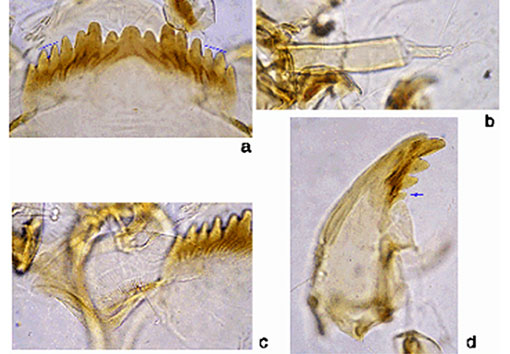C. 'tasmaniensis'
Known only from a single larva. Larva: a medium sized bathophilus-type larva. No measurements of body or ventral tubule lengths. Gula and frontoclypeus (FC) pale in the single known specimen. Ventral head length (VHL) 263 micron, width of mentum about 0.7 times the VHL.
Mentum (a, below) very similar to that of other members of the C. oppositus group. The teeth are rounded but this may be due to wear; the 4th laterals are slightly reduced, almost to the level of the 5th laterals (type I-II); the c2 teeth are relatively well separated (type IIA), but the division between the c2 and c1 teeth does not reach down to the level of the outer sides of the c2 teeth.
Ventromental plates (c, below) about 0.85-0.9 times the length of the mentum and 3.2 times wider than deep; separated by about a third of the mentum width; with about 28-30 striae; VMR 0.30-0.35.
Pecten epipharyngis difficult to see, but appears to have about 9 teeth, possibly type C. Premandible with broken teeth, but inner tooth about three times wider than the outer tooth.
Distance between the antennal bases may be slightly greater than that between the S4 setae, which are separated by 0.9 of the FC width at that point.
Antenna (b, below) with relatively long, narrow basal segment; A1 4.1 times as long as wide, and about 0.46 of VHL, RO about a third up from the base; AR about 2.04, relative lengths of segments (micron): 120 : 30 : 8 : 14 : 7.
Mandible (d, below) with third inner tooth pigmented and almost fully separated (type II-IIIB); 12 taeniae in the Pecten mandibularis and 16 furrows on outer surface near the base of the mandible.  Cytology: 3 polytene chromosomes with the modified pseudothummi arm combination AEG, BF, CD. Arm G unpaired with a Balbiani ring (BR) near the fusion with arm E and a second about the middle of the arm.
A nucleolus is developed in arm F with the NOR at about group 19.
No polymorphism in available specimen. tasA1: 1a-e, 2d - 3e, 1f - 2c, 10a - 11e, 8 - 9, 15 - 13, 7 - 4, 12a-c, 3i-f, 16 - 19 as oppositus A5
tasB1: Large puff (group 7) developed towards the distal end of the arm, with the dark bands (group 8) on the distal side. as oppositus B2
tasC1: Banding pattern not clear.
tasD1: Banding pattern not clear.
tasE1: 1 - 2d, 7g - 10b, 3e - 2e, 7f - 3f, 10c - 13 as oppositus E2
tasF1: 1 - 2a, 10 - 2b, 11 - 19(NOR) - 23 as oppositus F1
tasG1: fused to the end of arm E, with two obvious BRs. [ Return to Index | Go to C. oppositus adult ] |
